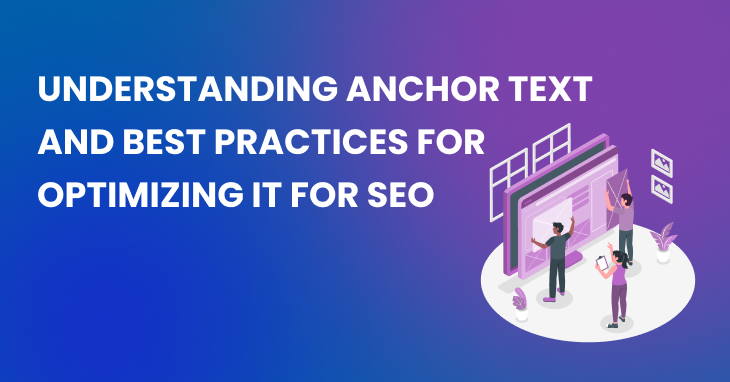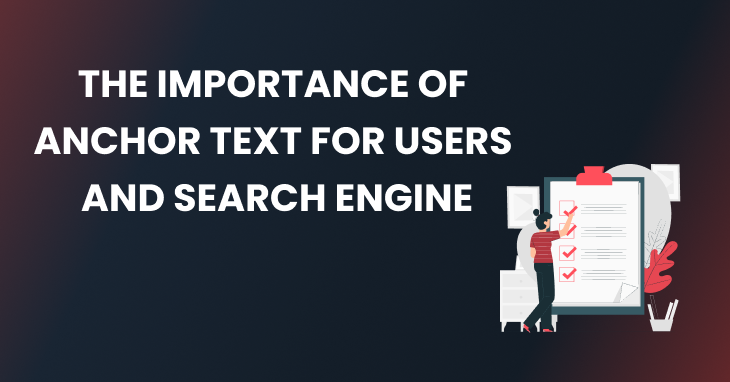I hope you enjoy reading this blog post.
If you want to get more traffic, Contact Us

Click Here - Free 30-Minute Strategy Session
Be quick! FREE spots are almost gone for this Month. Free Quote

Anchor text is a crucial component of the web, widely recognized as one of its most distinctive features. By enabling a smooth reference to external sources, it enhances user experience and expands the range of expression for content creators.
This article introduces anchor text, the significance of anchor text in SEO, and explores some of the best practices for optimising your anchor text to achieve top SEO results. If you want to boost your website’s search engine rankings, read on to discover the fundamentals of anchor text and how to make the most of it for your SEO efforts.

Click Here – Free 30-Minute Strategy Session
Be quick! FREE spots are almost gone for this Month

In the world of SEO, anchor text is a vital element that plays a key role in driving traffic to your website. Simply put, it refers to the clickable text in a hyperlink that directs users to another webpage. The appearance of anchor text has evolved but the key is to make it stand out on the page, so users can easily find and click it.
When it comes to anchor text, it’s not just about the visual style. The underlying HTML code is where the magic happens. Regardless of the website’s design, anchor text looks the same in the HTML code – a chunk of text between the <a> tags.
The purpose of anchor text is to provide users with a clear idea of where they will land after clicking a link. A URL address alone is not enough to convey the content of the target page. With the right anchor text, users can quickly identify the type of content they can expect.
To make the most of anchor text for SEO, it’s important to choose the right words. Anchor text should be relevant to the linked page, but not an exact match to the target keyword. Using variations of the keyword or descriptive text can help to make your anchor text more effective.
Lastly, anchor text can also take the form of clickable buttons, which can be a great way to draw users’ attention and drive more clicks. By following best practices for anchor text optimization, you can improve your search engine rankings and drive more traffic to your website. So, start incorporating effective anchor text practices into your SEO strategy today!
Learn More: Understanding the Importance of Internal Links

Anchor text is one of the most essential components of the web, recognized by users and search engines alike. It serves as a smooth pathway to external sources, amplifying the user experience and providing content creators with endless possibilities to express themselves.
Effective anchor text not only guides users to their intended destination but also provides them with additional information about the linked web page. This information enables search engines to better understand the content and relevance of the linked page.
Moreover, internal links with relevant anchor texts help search engines determine the site structure of a website, ultimately impacting search engine rankings. With the right anchor text, you can improve your website’s visibility and rank higher in search results.

Anchor text and backlinks are factors that influence search engine rankings. While their influence has fluctuated in the past, including relevant keywords in anchor text can strengthen a website’s ranking for that keyword.
To optimize anchor text for SEO, it’s important to consider which pages to link to. Only link to pages that meet the following criteria:
Using strategies like private blog networks (PBN) to manipulate anchor text for backlinks is now considered a “dirty” tactic. Google’s algorithm updates have made such methods less effective.
Anchor text is a key factor in search engine rankings. It is the visible, clickable text in a hyperlink that appears on a webpage. When a user clicks on this text, they are taken to another webpage. Search engines use anchor text to understand the context and relevance of the linked webpage.
Optimizing anchor text is important for SEO because it signals to search engines what the linked webpage is about. Relevant and descriptive anchor text can improve search engine rankings for targeted keywords. However, overusing specific keywords in anchor text can be seen as spammy and lead to penalties.
It’s important to ensure that the linked webpage is high-quality, relevant, and provides value to users. Only link to pages that add value to the overall user experience and are relevant to the content on the page.
Learn More: Internal Links SEO – 12 Pro Tips
Anchor text is the visible, clickable text in a hyperlink that redirects you to another webpage. It’s an essential aspect of SEO and proper use of it can significantly improve your website’s ranking on search engine results pages (SERPs).
Here are the different types of anchor text you can use for your webpages:
Exact-Match Anchor Text
Exact-match anchor text is the simplest type of anchor text, where the target keyword precisely matches the content, it’s linking to. It can help improve the page’s ranking for that keyword. However, overusing exact-match anchor text can lead to Google penalties.
Partial-Match Anchor Text
Partial-match anchor text includes variations of the target keyword or the keyword along with other words. It’s more descriptive than exact-match anchor text and can be used in page titles. It’s essential to balance the use of partial-match anchor text and other types of anchor text to avoid over-optimization.
Generic Anchor Text
Generic anchor text is not keyword-focused and consists of ambiguous phrases like “click here,” “read more,” or “here.” Such anchors provide no additional value to the users or search engines, and it’s best to avoid using them.
Naked Link Anchor Text
Naked link anchor text includes naked URLs that show the exact URL of the linked page. This anchor text works best when the URL is user-friendly and contains relevant keywords.
Branded Anchor Text
Branded anchor text includes the brand’s name and can help in building brand authority. It’s commonly used on external pages that link back to your website.
Image Anchor Text
Image anchor text uses the image’s alt attribute as the anchor text. However, it’s crucial to keep in mind that image anchors do not pass as much link juice as text links.
Search Engine Optimization (SEO) specialists often turn to Google documentation for guidance, and the search giant’s article on link text provides valuable advice on crafting a suitable anchor text. However, it is crucial to ensure that anchor texts are handled appropriately to avoid over-optimization.
Creating an SEO-friendly anchor text requires following some essential principles, which we have outlined below:
These SEO tips are especially important to keep in mind when creating anchor texts for your internal links. By following these principles, you can create SEO-friendly anchor text that enhances your website’s user experience and search engine rankings.
Learn More: Tips for Creating an SEO-friendly Urls
When it comes to SEO, anchor text is an essential element, but over-optimizing it can hurt your rankings. Google advises using descriptive, concise, and relevant anchor text that stands out. Avoid keyword stuffing and use generic anchors only when necessary.
Some SEOs suggest using percentage-based systems to implement different anchor text types for a ranking boost. However, research shows that the correlation between anchor text types and SERP rankings is weak, and there is no significant influence of surrounding link text on search results.
The key takeaway is to create compelling content that explores the topic deeply and from various viewpoints. This will help your page rank for many keywords naturally.
If you have any questions about optimizing anchor text or other SEO content tips, don’t hesitate to reach out to Traffic Radius’s technical SEO experts.
Google’s “Ranking based on reference contexts” patent, filed in 2004, describes a system where the text surrounding a link was considered as a potential SEO ranking factor. The patent states that a rare word (or words) from the text around the link could be used to create a context identifier, which would then be used to rank the linked page.
While it’s unclear if Google is currently using this system, testing it has become more difficult as the search engine’s ability to assess the entirety of a page’s content has improved.
As a result, the best practice for SEO is to use anchor text that accurately describes the content of the linked page. This advice is in line with what can be found in Google’s documentation on ranking factors in SEO.
Learn More: What Are On Page SEO Ranking Factors?
Understanding the different types of anchor text and their guidelines is crucial when developing your SEO strategy. Search engines prioritize relevant and descriptive anchor text that enhances the user experience, regardless of which type you choose. Links and their anchor texts are essential in helping search engine crawlers understand your website structure and crawl it more efficiently.
In the end, anchor text is a powerful SEO tool that should not be overlooked. However, it’s important to avoid spammy practices and links that distract users from the content they’re interested in.
To maintain a healthy website, it’s crucial to prioritise the needs of your visitors. At Traffic Radius, we specialise in helping businesses optimize their website’s SEO and increase their online visibility. Contact us today to learn how we can help your website rank higher in search engine results and attract more organic traffic.

LEAVE A REPLY